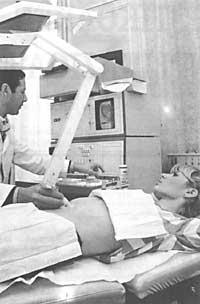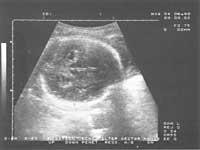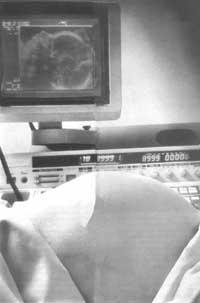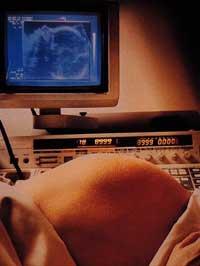News and implications of prenatal diagnosis
1991/07/01 Merino Santxo, Ana Iturria: Elhuyar aldizkaria
Until recently, the process of pregnancy and the creature in it have been a mystery to medicine. The characteristics we could have of this being were obtained by basic methods, so it was almost impossible to know how and when the time of childbirth would be. Over the course of nine months, women managed a totally unknown being, without knowing quite often the problems they could have or without being able to know them better.
What is prenatal diagnosis?

Thanks to the advance of new technologies, this situation has changed at present and there are already several (very sophisticated) ways to obtain information about the state of the fetus and thus consolidate the prenatal diagnosis. Prenatal diagnosis involves performing all the maneuvers that can be performed to know any anomaly that may present the fetus.
The number of congenital defects known today is more than five thousand, of which 80% can be observed by the methods mentioned. These congenital errors can be classified as:
- chromosomal abnormalities (12% birth defects)
- hereditary diseases (28%)
- malformations (60%)
As an example of chromosomal abnormalities, Mongolism (21 trisomies), congenital metabolic defects in hereditary diseases (enzymatic or hemophilia deficit, for example) and defects such as spina bifida or the absence of organs among many other malformations can be cited.
Methods of diagnosis
It can be said that we already have many possibilities to reach the fetus and that normally when deciding the diagnosis is used more than one method. Among them, and depending on their degree of aggression and aggression with the fetus or their environment, we distinguish two types of methods: non-invaders and invaders.

Among non-invaders we can cite the study of maternal blood. This study detects biochemical markers that supposedly accompany some anomalies. As an example of these markers we have alpha-fetoprotein (AFP) and alpha-gonad chorionic tropin (a-HCG).
However, the main resource used in prenatal diagnosis is probably ultrasound. This allows to analyze the internal and external structure of the fetus. The technical basis of this method is the emission of ultrasound. These ultrasounds are reflected in different fetal structures and are displayed on screen with the help of the computer. This technique allows to diagnose most physical errors.
In invasive methods we will mention amniocentesis, corial biopsy and biopsy and funiculocentesis of the different fetal tissues.
Amniocentesis
It consists of obtaining a sample of amniotic fluid that bathes the fetus through the puncture of the mother's uterus. In this amniotic liquid is a number of cells of the fetus due to the physiological process of decontamination, so there are also elements of the skin, urinary tract, etc. The study of these cells, which usually require a cell proliferation so that the number of fetal cells is acceptable for diagnosis, allows to obtain fetal karyotype and thus diagnose any chromosomal alteration of the fetus. At the same time, different biochemical studies can be carried out. The best results are obtained when puncture is performed on an outpatient basis in week 14-16 of pregnancy.


Corion biopsy
It consists of obtaining a sample of corionian hair, both through the abdomen and through the neck. Coriona is the membrane that has the embryo and surrounds it, being the fetal part of the placenta. The sample is extracted in week 8-12 of pregnancy. In this way, the diagnosis is made on time and the need to go to the hospital is also avoided. Its drawback is that it is slightly higher than the rate of abortion of amniocentesis
In some cases it is not possible to obtain the diagnosis either through the amniotic fluid or from the hair of the corion. Then biopsies of different fetal tissues are performed: skin, liver, etc. Sometimes it can be interesting to obtain fetal blood through different techniques. The most common is funiculocentesis, that is, puncture in the umbilical cord. In these cases the risk of loss of the fetus is 3-5%.
Within the invasive techniques is fetoscopy. This technique consists of the introduction of an optical system in the uterine cavity.
Suitability and risk groups
As a result of all these data, the need to establish specific indications is clearly seen. Establish the most appropriate type of test in each case, especially taking into account the risk of fetal loss of some.
Therefore, high-risk groups are defined according to the effects of alterations that have occurred throughout the history of the family, the age of the parents, the influence in certain circumstances of teratogenic factors (intake of toxic substances, irradiations, infections), etc.
Social cost and implications
In recent years, interest in prenatal diagnosis has increased. In the source of this interest there are different factors. Congenital errors are the main cause of prenatal mortality in these years, mainly due to the decrease of other causes of infant mortality. On the other hand, it is perceived that this pathology is multiplying by the current habits of life. The reduction of birth and the delay of maternal age are also of greater importance, since in society the health of children is increasingly observed.

From the economic point of view it is much more profitable to promote prenatal diagnosis programs than to respond to the maintenance costs of congenital failures.
To know the true need for these prenatal diagnosis programs of today, different types of statistics are elaborated, in which it is seen that the incidence of congenital errors is around 5%, that is, about one in every twenty pregnancies. This percentage of birth defects is related to prenatal deaths, which cause about 34% of deaths and 20% of the first year after birth
In spontaneous abortions, it has been observed that fetuses present numerous chromosomal or morphological defects. On the other hand, congenital errors are the first cause of brain diseases (29.5%) and the cause of many physical errors.
The aforementioned figures show by themselves the need to promote a prenatal diagnosis, since their social implications are clearly reflected.
The problem is different when dealing with the problem and helping affected people after diagnosing the congenital error. In all cases, it is advisable to give direct and objectively qualified professional advice, leaving aside the decision of the woman or the couple. All people have the right to receive detailed information about prenatal diagnosis (with their risks) and about the problems that a specific pregnancy can have.
The situation in Spain: that of always

It is estimated that every year in Spain they are born by a congenital error 25,000 children. However, the delay compared in this matter with other European states is quite remarkable. At the same time, the pregnancy rate of women over 35 in Spain triples the rate of other states. Although it is considered a high-risk group, less than 7% of them agree to perform fetal karyotype examination tests. In the rest of the EEC countries, the figure ranges from 30% to 70%.
With this data it is confirmed that the situation here is quite bad, especially in the environment. Starting to seek responsibilities, we will find ideological and administrative barriers, lack of staff always, lack of resources, etc. Without forgetting. It must be said that the time has come for those responsible for this area to really face the problem. Meanwhile, the situation that is common at the general level of research will be confirmed: the lack of almost interest in strengthening and promoting research in institutions.

Gai honi buruzko eduki gehiago
Elhuyarrek garatutako teknologia






